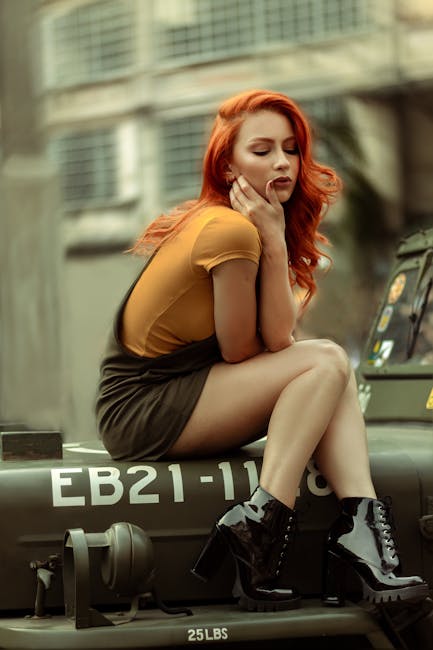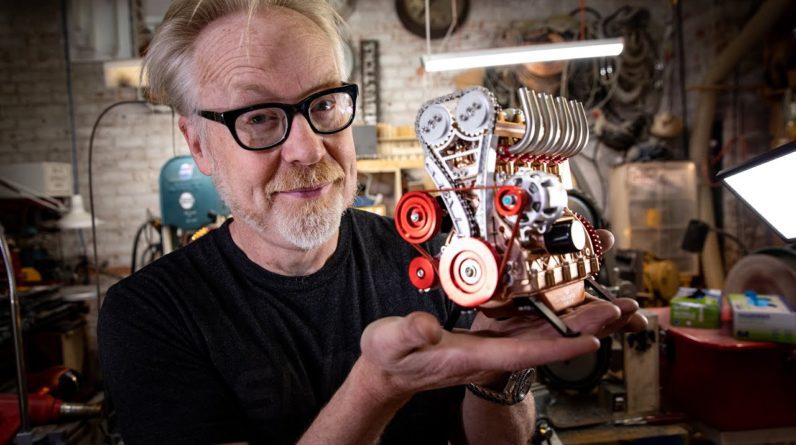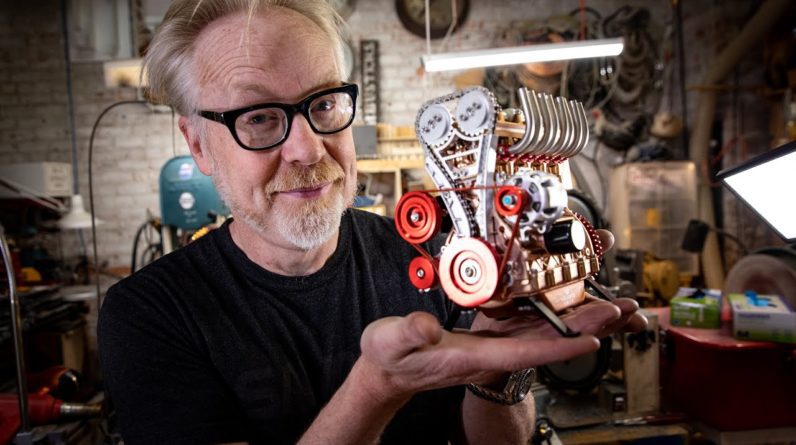My friends, tonight I want to show you something
different. This unassuming box contains… the best way to put it is a model from
the future. So the company is called Resinscales and the kit inside is an AMX-50B.
What makes it so different from anything I’ve built so far is the technology – the model
is completely 3D printed. This technology is becoming the new standard in our hobby and
we can already find tons of aftermarket items that are made in this fashion, but as far as I can
tell, this is the first company selling complete models in 1/35th scale. The greatest advantage is
the low part count while the amount of details is the same as with any high-quality plastic kit.
And it really shows, an entire lower hull made as a single piece with everything in place –
grab handles, cables, the entire engine deck, mesh screens, turret with every hatch, periscope
and lifting hook, smoke dischargers… okay here I managed to break one, and the running gear.
Just
a few parts and it should look like any other kit. I highly appreciate the sharp detail on the
inner side of the tracks. And the small parts are something I’d appreciate in plastic kits, such as
the headlight covers that look better than plastic or photo-etched parts. And the 50 cal with a
hollow thermal sleeve is also a nice feat of modern engineering. There’s also a one-piece gun
barrel with a supplied carbon rod that ensures it won’t bend down, let’s say from heat… and
a pack with some metal stuff and magnets. So that’s everything we’re getting with the
kit, there are no decals or instructions, but the assembly should be pretty straightforward.
The first “construction step” if you will, is removing the scaffolding.
No, I’m not
gonna use scissors, because check this out, I finally have a set of fancy sprue nippers!
The process is pretty fast on these large parts. They’re sturdy enough and even if you handle
some of the supports with brute force, it’s not gonna cause too much damage, especially
in places that are gonna be hidden. In fact, some of the supports got broken during the
transportation. Resin is quite brittle, so it can be expected. Nonetheless, it makes
the job much easier! In less than 10 minutes I had the entire turret… The hull was even faster,
here I could just break them off because none of this is gonna be visible.
And in less than
15 minutes, I had most of the kit finished. Or did I…. Well, here I wanted to see how long
it would take to remove the entire running gear… but uh, let’s just say I quickly realized it
wouldn’t take 10 or 20 minutes. So… I got bored. I ended up spending an entire evening removing
those parts, and the biggest problem I see here is the layout. They’re tightly packed
together, which is completely understandable, but on the other hand, you often have problems
getting to those supports, let alone removing them safely. No matter how delicate I was trying
to be, I damaged the tracks in a few places. Maybe I wasn’t using the forbidden Jutsu of 3D printing,
but it wasn’t easy.
Maybe I should’ve used a razor saw… well, I can only speculate now. But
hey, I’ve got everything removed! And again, regardless of the time spent on the running gear,
I’m still very impressed. Such a low part count for a totally legit and highly detailed 1/35th
scale kit is amazing, so let’s continue, shall we? So the next obvious step is the clean-up.
Luckily, the resin is very easy to sand and here we can hit two flies with one
stone. Get rid of the support remnants, and also knock down the subtle layering, which
is always gonna be present on 3D printed models. Resin produces a metric ton of dust, so
it’s important to protect your breathing machinery. Resin is also very brittle like
I’ve already mentioned, and it’s very easy to damage. By accident, or on purpose, which
makes adding realistic damage to the rubber cladding on the wheels a walk in the park.
The tracks were already damaged enough, so I had to focus on repairing them. At first, I
wanted to just hide those flaws with thick layers of mud, but what kind of modeler does that? I’m
sure no modeler ever would hide their mistakes with weathering, right? Anyway, I built up the
missing material with superglue, and once it was rock hard, I sliced off the excess, basically
sculpting the missing track segments out of glue. It’s not gonna be as pretty as the rest, but at
least there won’t be any holes in the tracks, and I think it won’t even matter
once they’re painted and weathered. The assembly went fine, but the swing arms for
the outer wheels are slightly bent, resulting in levitating road wheels.
The most elegant remedy
I could think of is snapping them off… okay, there might be a fancier way, using expensive side
cutters. I didn’t wanna try bending them in hot water or anything, because 3D resin doesn’t
always react well with that, and, you know, they won’t bend back into the original position
a week later. I just made sure to completely cover them with superglue so the entire structure
will become tough as nails and none of them would break off later. I think this was an issue with
this particular kit due to how the suspension is designed… other models will probably be just fine.
But hey, it worked and it looks way better now. I also filled some of the holes with superglue
and the large drainage hole with a heated-up plastic sprue. These holes are used to remove
the excess resin from the inside of the print. The turret basket is designed with this
raised lip, so it can rotate freely above the engine deck. However, this is
not how the real thing looks like, and my solution was to glue a strip of thin
copper around the entire basket.
This way I could glue it perfectly flush with the hull,
and once it’s filled, sanded, and textured, it will be barely noticeable. However, there
should be a tiny gap around the turret ring, so I made a few rudimentary circles from plastic
sheets and glued them underneath the turret. The printed grab handles are beautiful, but the
big ones can be very fragile. I’d definitely snap them sooner or later, so I just decided to get
rid of them and replace them with wires later.
Okay, the last brutal treatment is scribing.
This model doesn’t come with any weld details, except two on the turret, but that’s not an issue,
I think those would be too much even for high-tech printers. I was able to reference all of them from
a few museum photos of the real tank that can be quickly googled, as well as an HD render from
World of Tanks which is extremely detailed and accurate.
Resin behaves very differently compared
to plastic, but it’s quite easy to scribe. What I didn’t quite appreciate are some of these panel
lines that are modeled as raised details, or how aircraft modelers refer to them – positive panels.
Other panels on this model are printed normally as negative details, so I’m guessing it’s not a
limitation of the technology, just a creative decision. It’s okay though, but the model is gonna
look a bit more authentic when they’re re-scribed. I’ve built a few resin kits in the past and
I’d say the main difference between them and plastic kits is the type of work. You
can spend the same amount of time on both, but with plastic, you’re assembling the
kit from hundreds of pieces, while with resin you’re mostly cleaning up and refining
a few parts. Well, let’s get to the fun part! My definition of fun is texturing. Roughening the
surface with a rotary tool causes even more dust, so again, a gas mask is essential. There
is a slight hint of cast steel texture, and some of their other models are even better
in this department, but I wanted to make it more visible.
Not gonna lie, I made it much heavier
than it is on the real tank, but it was all purposeful. One of the things I wanted to try is
using acrylic wood putty for the heavy texture. I noticed how good it works on diorama stuff
such as styrofoam concrete and so on, and yeah, it works just as well on models. I applied it very
sparingly though because it has a lot of volume, but then again, it’s easily knocked down with
some gentle sanding.

The second layer, as usual, is Tamiya putty diluted with Mr. Cement S. It
behaves differently on resin because the putty or the cement won’t attack the surface as it does
on plastic kits, but it sticks to the surface without any fuss. This was then knocked down with
a fine sanding sponge which removes the ugly bits, and levels out the raised texture, making it more
subtle and authentic. And more refining was done by stippling even more putty, but this time
it was more diluted. Because the model doesn’t react with modeling cement, it’s easy to wipe
off any unwanted putty from smaller details, keeping the build nice and clean. The rolled
steel plates have a much smoother texture, so two or three layers of diluted
putty are gonna be enough here. And now it’s time for the obligatory welding.
This is the standard method I use on all my models – Tamiya Epoxy Putty Quick Type rolled into
thin worms. In fact, I summed up and explained all these texturing techniques in one of my older
videos, so if you’re not familiar with them, it’s worth checking out.
If you already know
them, I just wanna add that this tank has some insane welding. The whole turret has
a pretty complex shape, and basically, the front part is a huge steel casting while the
remainder is welded from steel plates, but yeah, some of the shapes are pretty wild. However, it
definitely adds a lot of visual detail and it’s gonna be a treat to post-shade and pin wash this
model. The casts also have visible seam lines made by the sand mold.
These can be replicated
in the same way, only without texturing. So here it is with the heavy metal treatment
completed. Another interesting detail is that this tank has corner welds, so we
don’t see the armor plate cross-sections, something that’s fairly common
on most of these old tanks. Now I had to fabricate the handles from copper
wire. I was looking forward to this step because Rob, one of my Patrons, decided to make his own
grab handle bending tool. I provided him with some feedback and he ended up making this tool
with half-millimeter increments. So unlike the previous tool I had, where it was pretty much
impossible to hit the correct dimensions, I was able to make all three and make them fit perfectly
into the pre-drilled holes. The smoke launchers also had small handles, but I bent these over a
pair of tweezers because they were just too small. I also got curious about the barrel. Usually,
I hit them with the obligatory red primer to spot any imperfections or seam lines on plastic
barrels, and in this case, it was to see how’s the print quality.
Well… I don’t know about
the rest of the kit, but this looks perfect. Okay, going back to adding what I had to remove, I
made lots of plastic bolt heads using the RP toolz punch and die set. I had to remove the original
ones while I was re-scribing the panel lines, and the perfectionist in me wanted to replace
all of them, so they’d look all the same, but I also want to see how the 3D
technology looks once it’s painted. So the finished model will have a mish-mash
of digital and analog bolts heads. As usual, I used my favorite
combo of VMS black superglue and their debonder or super glue remover. Being
able to efficiently remove any unwanted glue is a total game-changer because it turns a rather
messy job into a perfectly clean finish. The remaining parts from the kit are simply
beautiful.
This is the type of stuff I’d love to see in the more mainstream models. Okay, working
tow shackles are really fancy and not always needed, but one piece, in-scale headlight covers
would be pretty sweet, especially in all those Sherman kits, because plastic ones are very thick
and photo-etched are not that easy to assemble, so this would be a sweet spot for everyone.
Realistic for more demanding modelers while keeping the assembly easy for regular hobbyists.
The only real 3D printed blunder was this trap door on the turret where spent shells were ejected
by the autoloader mechanism, you know what I mean? And that’s the model as it comes out of the
box, with a few improvements here and there. It’s an impressive tank and it’s truly humongous,
but… since it’s pretty much a what-if model because France only made 5 prototypes of this
tank, I wanted to make it more customized.
Well, this is more of additional detail, but
basically, the single-piece printed machine gun wasn’t easy to clean, and I managed to scrape
off some details from the ammo canister. Well, adding a photo-etched lid solved both issues – the
damage is hidden and the model is more detailed. Luckily I never throw away unused photo-etch,
it doesn’t take up too much space and it’s a valuable source of various details for all kinds
of models. This also applies to plastic parts, especially when you’re left with some unused
engineering tools, exhausts, tracks, wheels, whatever. You never know when they’re gonna
come in handy. It’s hard to tell where I got some of these, but I know the tow cable
comes from the Meng Jagdpanther I built before this, the ax and crowbar are from a Rye Field
Model Tiger, and… yeah, spare parts are good! I didn’t have any unused antenna mounts,
so I quickly modeled and printed my own. They’re not very accurate,
but it’s better than nothing. And to finish it off, a resin figure from
Panzer Art to give the model a human element, but also to show how massive the
tank was.
It’s an absolute unit. Anyway, my friends, one more thing about
the figure. From my very limited research and the few photos I was able to find, it seems
to me that post-war French uniforms were almost identical to American ones. Maybe the color
was slightly different, but I can’t tell from black and white pictures, but that’s the
reason I used an American tanker figure. As for the model itself, it’s seriously the most
impressive resin kit I’ve ever built. I was never best friends with resin, but I’ve done a few of
them in the past.
Most of the time my experience was pretty painful except for one amazing kit
from a Czech company Plusmodel. But this puts the term “resin kit” to a whole new level. I’m a
huge fanboy of 3D printing, I just love the idea of converting something digital into a real-life
object and this kit, along with every other model from Resinscales, shows perfectly how far the
technology has progressed. My only constructive input would be the tracks – I think they’d be much
easier to assemble if they were made as individual moving links. It might seem counterintuitive,
but these static tracks required a lot of work and the fit is pretty tight. Assembling individual
working tracks would take probably the same amount of time, if not less, and the result would be
far better and more satisfying. Considering these models are not the cheapest, this one cost
me 130 euros, I think it would make the experience much better. But other than that, I’m very
impressed. Resin is just different than plastic, so the building experience and the required
assembly techniques are also gonna be different. I think 3D printed models are gonna become an
established part of our hobby in the near future, so I hope you enjoyed this video where we took a
glance at how it might look like in a few years. And also, a huge thank you goes to my Patrons.
My
Patreon feed is like a magazine subscription where you can get very frequent, almost daily updates
from all my projects. I’ve shared more thoughts about this model there, and there’s also more
information about anything I work on. We can also get in touch through DM’s and comments, you can
watch one week early ad-free videos, and I also have these beautiful studio photos which you can
download in full resolution. Something else that you can download and might find interesting are
real-life references and inspirations for dioramas and small 3D models made by yours truly, which
you can print yourself if you have a 3D printer. Anyway, that’s gonna be it for tonight, my
friends, I’m gonna go post-shade and pre-weather the life out of this kit so we can see how it
looks painted.
Until then stay safe, stay awesome, keep building those models, don’t just collect
them, and I’ll see you in the next one, cheers!.






